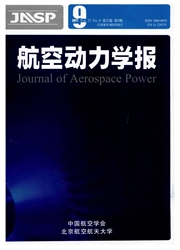

 中文摘要:
中文摘要:
以可压缩黏性流动的数值模拟为研究背景,发展了一套自适应混合笛卡儿网格(AHCG)方法以及基于有限体积方法的雷诺数平均Navier-Stokes(RANS)的数值求解方法.为更好地模拟边界层的黏性流动在近壁面处采用贴体结构网格,剩余计算区域自动生成与之相重叠的笛卡儿网格,并同时发展了基于流场特征的笛卡儿网格自适应技术.结合ADT(alternating digital tree)算法显著减少了网格生成中“挖洞”和“贡献单元”搜索的消耗机时,50万左右的网格数目下,搜索耗时为0.062 s,仅为普通遍历方法的1/1847.通过二维圆柱与两段翼型绕流的数值算例显示,定常AHCG方法能够准确地预测物面压力分布与升阻力系数并且具备处理复杂外形的能力;同时通过二维非定常圆柱绕流问题与NACA0015矩形机翼翼尖尾涡的捕捉算例显示,结合了动态自适应网格加密的非定常AHCG方法尤其适用于旋涡主导流动.
 英文摘要:
英文摘要:
An adaptive hybrid Cartesian grid (AHCG) method with a finite volume type Reynolds average Navier-Stokes (RANS) flow solver was developed for simulation of compressible viscous flows. While the near body region was provided with body-fitted struc- tured grids to resolve the boundary layers, the remaining computational domain was tessel- lated with generated Cartesian grid, and feature-based grid adaptations were carried out for simulating the flowfield more accurately. By using the ADT (alternating digital tree) algo- rithm, the costed turnaround time of chimera type hole-cutting and identification of donor cells could be decreased very efficiently, and 0. 062 s was costed, up to only 1/1 847 of the normal traversal approach when the grid number reached 500 000. Through simulations of flow past 2-D cylinder and 2-element airfoil, it is concluded that steady AHCG method can predict surface pressure distribution, lift and drag coefficients successfully and has the ability of solving complex configurations. The simulation of unsteady flow past 2-D cylinder and the capture of 3-D wing tip vortex past a NACA0015 rectangular wing demonstrates that un- steady AHCG method with dynamic adaptive mesh refinement is especially suited for vortex- dominated flows.
 同期刊论文项目
同期刊论文项目
 同项目期刊论文
同项目期刊论文
 期刊信息
期刊信息
